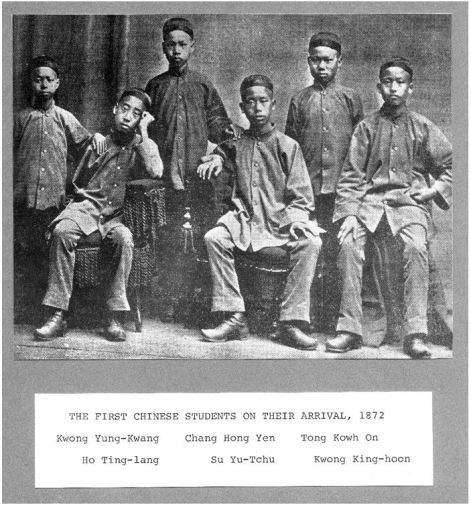By Barbara Austen
Yung Wing had a dream. He wanted Chinese youth to study American technology to improve China’s engineering and infrastructure. As a boy, he had attended Monson Academy in Massachusetts and then graduated from Yale in 1854. Upon his return to China, he became a strong advocate for the western education of Chinese students and was able to convince the Chinese government to support his project. He was assisted in large part by the 1868 Burlingame Treaty that provided for mutual rights of residence and attendance at public schools for citizens of the United States and China.

The first Chinese students on their arrival. Photograph, 1872 – Connecticut Historical Society
A group of 30 students ranging in age from 10 to 14 arrived in Hartford in 1872 after a brief period of preparation at home. The young men lived with host families in Connecticut and Massachusetts, where they were immersed in the English language and American customs. They arrived wearing traditional Chinese garb but soon adopted American styles and customs. They attended local schools, including West Middle School and Hartford Public High School.
In 1874, the Chinese Education Mission constructed a headquarters, at 352 Collins Street in Hartford, where, in the summer, the boys studied Chinese classics and culture. However, the students tended to neglect their Chinese studies and became more and more Americanized. This (and other factors, including finances and a US breach of the Burlingame Treaty’s terms) prompted the Chinese government to recall the students in 1881.
In all, 120 Chinese students came to live and study in New England during the 9 years that the program was in operation. When they returned home, these young men entered the diplomatic service, worked as engineers on infrastructure such as railroads, and served as naval officers, physicians, educators, administrators, and magistrates—thus fulfilling, at least in part, the original vision of Yung Wing.
Barbara Austen is the Florence S. Marcy Crofut Archivist at the Connecticut Historical Society.
© Connecticut Public Broadcasting Network and Connecticut Historical Society. All rights reserved. This article originally appeared on Connecticut History | WNPR News
Note: ConnecticutHistory.org does not edit content originally published on another platform and therefore does not update any instances of outdated content or language.









